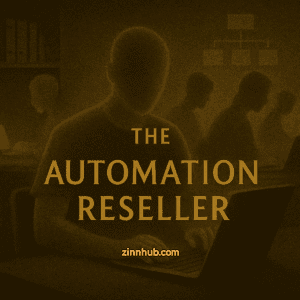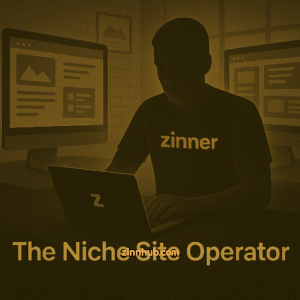Table of Contents
- The Workforce You Can’t See But Can’t Ignore
- What Is the Shadow Workforce?
- Why the Shadow Workforce Has Exploded
- The Double-Edged Reality of Shadow Work
- Who’s In This Shadow Economy?
- 👤 The Invisible Agency
- 💼 The Brandless VA Army
- 📝 The Ghost Content Creator
- 🧠 The Automation Reseller
- 🧪 The Stack Operators
- Automation Resellers Vs. Stack Operators
- 🎨 The Crafty Creator
- 🎬 The Visual Promoter
- 🎧 The Audio Specialist
- 🧾 The Data Wizard
- 📚 The Course Cloner
- 🌐 The Niche Site Operator
- 💡 The Idea Flipper
- Niche Site Operator V’s Idea Flipper
- Why the Shadow Workforce Needs Infrastructure
- Enter Zinn Hub: Professionalising the Invisible Economy
- How Zinn Hub is Addressing the Shadow Workforce Challenge
- What’s Next: From Shadow to Spotlight
- Work Has Changed – So Should the Tools
The Workforce You Can’t See But Can’t Ignore
Forget job titles. Forget corporate ladders. Forget everything you think you know about remote workers.
Behind the rise of remote work lies something bigger and far more disruptive – an invisible economy made up of millions of individuals operating outside traditional systems. No offices. No job boards. No LinkedIn announcements. No Facebook ads. No portfolios. There are no public proposals on marketplaces. Just work – done quietly, skilfully, and often anonymously.
This is the Shadow Workforce: a sprawling, decentralised network of digital workers, micro-agency founders, ghost creators, AI automation resellers, and plug-and-play specialists who power the global economy from the backend. And in 2025, it’s not just growing – it’s exploding.
What Is the Shadow Workforce?
At first glance, the shadow workforce might look like a chaotic patchwork of freelancers and digital nomads. But take a closer look, and you’ll see:
- Ghostwriters crafting thought leadership for influencers who never touch a keyboard
- Virtual assistants quietly running entire backend operations for eCommerce brands
- Automation experts selling no-code Zapier stacks that replace whole departments
- Copy-pasters reselling “gigs” on Facebook groups for double the price
- AI “operators” using GPTs and Claude bots to deliver entire services behind a brand name
- Craft-based entrepreneurs using Cricut and Etsy-style platforms to create personalised goods for friends and family are now expanding into micro-brands and boutique gift shops online
These aren’t just side hustlers. They run an informal, fluid, and highly functional economy that legacy job platforms never intended to support.
Why the Shadow Workforce Has Exploded
Several converging factors have driven the rapid expansion of the shadow workforce:
- Technology platforms that facilitate easy connections between workers and those seeking services
- Corporate strategies focused on labour flexibility and cost reduction through outsourcing
- Regulatory arbitrage that exploits gray areas in employment classification
- Economic pressures that force workers to accept precarious arrangements
- Immigration policies that create populations willing to work outside formal systems
- Changing worker preferences for flexibility and autonomy
These forces have not only fuelled growth – they’ve created an entirely new class of global remote workers operating at the edges of formality.
The Double-Edged Reality of Shadow Work
Shadow workers occupy a contradictory position in modern economies:
- They are essential to daily operations yet largely invisible in economic statistics
- They provide flexibility that consumers demand while bearing the costs of that flexibility
- They create enormous value for platforms and corporations while capturing a diminishing share
- They’re celebrated for entrepreneurial spirit while lacking basic protections and security
This paradox illustrates why platforms like Zinn Hub are so critical – not just as enablers of work but as reformers of the entire digital ecosystem.
Who’s In This Shadow Economy?
This workforce isn’t defined by resumes or degrees. It’s defined by execution, speed, and adaptability.
Here are the key players:
👤 The Invisible Agency
One-person brands masquerade as agencies, utilising contractors, templates, artificial intelligence, and quick delivery methods.
This is a “one-person agency” that appears as a full team from the outside, but is actually a single operator managing everything behind the scenes using automation, AI, and outsourced talent.
How The Invisible Agency Works:
- The facade: The person builds a website, brand, and service menu that looks like a boutique agency – complete with case studies, client logos, and even “team” pages.
- The backend: They fulfil services using:
- Templates and SOPs (standard operating procedures)
- Offshore or gig-based contractors (via Fiverr, Discord, private VA groups)
- AI tools (ChatGPT, Claude, Canva, Copy.ai)
- Automations (Zapier, Make, Airtable)
Tools The Invisible Agency Typically Uses:
- Notion or ClickUp for client management
- Canva Pro or Figma for design workflows
- Trello or Airtable for tracking tasks
- ChatGPT or Claude for client-facing copy
- Framer, Webflow, or Carrd for rapid landing page deployment
- Stripe + Zapier to automate onboarding and billing
Real-World Examples of The Invisible Agency:
- A “branding agency” that delivers $500 logos using pre-bought templates + AI-assisted revisions
- A “content marketing firm” run by one person using GPT + a VA who schedules posts
- A “SEO agency” using Surfer SEO, Jasper, and marketplace freelancers – all managed through a Google Sheet and Slack
Why Clients Don’t Notice The Invisible Agency (or Care):
- Speed & value win – many clients care more about outcomes than headcount
- Polished frontend – great branding and onboarding can create confidence
- Efficiency > manpower – Invisible Agencies often outperform real teams
Why The Invisible Agency Thrives in the Shadow Workforce:
- No traditional credentials required
- Low cost to start – often under $100
- Leverages platform arbitrage (buying low on one site, selling high elsewhere)
- Fully remote, scalable, and semi-anonymous

💼 The Brandless VA Army
A distributed network of virtual assistants who operate entirely through referrals, private groups, or agency-style resellers, or public marketplace presence. They’re invisible, reliable, and often the real operators behind “one-person teams”.
How The Brandless VA Army Works:
- The work: Anything from inbox management and calendar scheduling to customer support, blog formatting, research, file organisation, or publishing tasks.
- The setup: These VAs:
- Work through DMs, email, or WhatsApp – not formal platforms
- Are paid via PayPal, Wise, GCash, or crypto – not payroll
- Often serve 2–5 clients concurrently
- Use Google Docs, Trello, and ClickUp more than Upwork dashboards
Tools The Brandless VA Army Typically Uses:
- Gmail + Google Calendar for email/inbox/calendar management
- Trello, ClickUp, or Asana for task tracking
- Google Docs/Sheets, Notion, or Canva for deliverables
- Slack, Telegram, or Messenger for communication
- Zoom, Loom, or Otter for meeting notes and client updates
Real-World Brandless VA Army Examples:
- A VA who manages an entire newsletter publishing workflow – from drafting outlines to uploading the final email in ConvertKit
- A team of 3–5 VAs working in rotation to cover a solopreneur’s global customer support inbox
- A ghost-VA for a coach who replies to DMs, sends resources, and updates onboarding sequences behind the scenes
Why Clients Use The Brandless VA Army:
- Ultra-reliable and cost-effective
- Often more skilled than public “VA profiles”
- Clients prefer quiet execution over visible freelancers
- Many VAs build long-term client relationships quietly and consistently – even across years
Why The Brandless VA Army Thrives in the Shadow Workforce:
- No branding, no bidding wars – just quiet referrals
- VAs often trained in private communities, mentorship groups, or past agency gigs
- Invisible to search engines, invisible to LinkedIn
- They’re essential to many online businesses, yet completely unlisted

📝 The Ghost Content Creator
A behind-the-scenes content producer who creates high-quality work under someone else’s name, brand, or company – often under NDAs or private agreements. They don’t get credit, but they power entire content ecosystems.
How The Ghost Content Creator Works:
- The work: articles, emails, scripts, social posts, eBooks, product descriptions, and entire online courses – all published under the client’s identity.
- The relationship: Typically ongoing, white-labelled, and non-public:
- No public portfolio or author byline
- Paid per piece, per month, or retainer
- Often found via referrals, Discords, or DMs – not content mills
Tools Ghost Content Creators Typically Use:
- Google Docs, Notion, or Scrivener for writing and collaboration
- ChatGPT, Claude, or Copy.ai for assisted ideation
- Grammarly and Quillbot for polishing
- Airtable, Trello, or Slack for managing content calendars
- Sometimes Surfer SEO, Frase, or ClearScope for SEO-focused work
Real-World Ghost Content Creator Examples:
- A ghostwriter who writes LinkedIn thought leadership posts for 3 tech CEOs
- A content strategist ghost-creating entire email marketing flows for SaaS brands
- A writer producing 8 articles per month for a blog they’re never credited on
- A short-form content ghost who scripts TikTok and YouTube Shorts for creators
Why Clients Love The Ghost Content Creators:
- Removes the burden of writing and thinking from the founder/creator
- Content feels personal – but is actually outsourced
- Great ghostwriters are hard to find and kept secret by those who hire them
- Often become strategic partners, not just freelancers
Why The Ghost Content Creators Thrive in the Shadow Workforce:
- Ghost creators can charge premium retainers – while staying anonymous
- Most clients prefer discretion and long-term trust over visibility
- No need for portfolios – referrals speak louder
- Often work through agencies or as “unnamed team members”

🧠 The Automation Reseller
A non-technical operator who sells done-for-you automation business services – often using tools they didn’t build, but deeply understand how to configure, manage, and resell. They don’t write code; they wire systems together.
How Automation Resellers Work:
- The offer: Set up automated workflows for small businesses, solopreneurs, and agencies – e.g. lead capture, email sequences, calendar syncing, data pipelines, and client onboarding.
- The backend: Uses tools like:
- Zapier, Make (Integromat), Pabbly – for workflow automation
- Airtable, Google Sheets, Trello – as databases or task managers
- Notion, Typeform, Calendly, Stripe – as client inputs/triggers
- Often resells prebuilt templates and connects them to real business use cases.
Tools Automation Resellers Typically Use:
- Zapier for multi-app logic and triggers
- Make for visual, modular workflows
- Airtable for relational databases and client dashboards
- Slack, Gmail, Google Drive, Stripe, Calendly – common endpoints
- Notion for client-facing automation dashboards
- ChatGPT to generate email content, conditional logic ideas, or dynamic instructions
Real-World Automation Seller Examples:
- Sells a “Client Onboarding System” for coaches: Typeform → Notion → Stripe → Google Drive → Gmail
- Builds and sells Zapier flows that link CRM (e.g., Pipedrive) with task managers (e.g., ClickUp)
- Offers setup of “lead magnet auto-delivery systems” for creators using ConvertKit + Webflow + Airtable
Why Clients Buy From Automation Resellers:
- Most small businesses don’t want to learn automation tools
- They’re overwhelmed by Zapier’s UI or don’t know what’s possible
- The reseller speaks “business language,” not code – and solves specific pain points with clarity
Why Automation Resellers Thrive in the Shadow Workforce:
- No need to code or build SaaS
- High perceived value, low marginal cost
- Clients often stay long-term for maintenance or tweaks
- Most resellers build once and sell many times
- Resellers often learn from free YouTube channels or communities – then monetise their execution speed

🧪 The Stack Operators
Tech-savvy freelancers who master a specific tool stack or micro-ecosystem and offer highly specialised services that connect or enhance those tools. They don’t build products – they assemble and optimise systems.
How Stack Operators Work:
- The approach: Stack Operators don’t code from scratch. Instead, they combine best-in-class tools (often no-code or low-code) to solve business problems fast.
- Their offer:
- Set up dashboards, workflows, or apps
- Migrate teams to a new system
- Optimise existing setups for performance, UX, or reporting
- Integrate 3–5 tools into one seamless experience
Tools That Stack Operators Typically Use:
- Notion, Airtable, or Coda for knowledge/workspace systems
- Zapier, Make, or n8n for interconnecting tools
- Framer, Webflow, or Tilda for building polished frontends
- Figma for UI/UX design or handoff
- Calendly, Stripe, Google Workspace, etc., as plug-ins to the stack
- ChatGPT / Claude for enhancing prompts, logic, and UI text
Real-World Stack Operator Examples:
- A freelancer who builds “Client Operating Systems” for agencies in Notion
- A solo consultant who assembles no-code CRMs using Airtable + Softr + Make
- A designer/developer who rebuilds client onboarding in Framer with API hooks
- A stack expert offering fully functional lead gen dashboards in Coda for consultants
Why Clients Choose Stack Operators:
- Don’t need to hire an expensive dev team – just a fast, efficient builder
- They already know the tools inside-out
- They deliver polished, scalable results in days, not months
- Great for MVPs, internal ops, and lean teams that value agility over bloat
Why Stack Operators Thrive in the Shadow Workforce:
- Most clients don’t even know these tools can be used this way – Stack Operators educate + execute
- No formal job board exists for this work – it spreads via word of mouth, Twitter/X, YouTube, and Discord
- Low barrier to entry, high margin, no-code-friendly
- Highly productised, repeatable services = scalable solo success
Automation Resellers Vs. Stack Operators
| Feature | 🔁 Automation Reseller | 🧪 Stack Operator |
|---|---|---|
| Main Focus | Automating workflows between tools | Building full systems using tool stacks |
| Client Outcome | “This happens automatically when that happens.” | “Here’s a complete system you can use and manage.” |
| Primary Tools | Zapier, Make, Pabbly, Airtable, Sheets | Notion, Coda, Airtable, Framer, Webflow, Zapier, Figma |
| Skillset | Workflow logic, triggers, actions | Project-based, productised service, or retainer |
| Deliverable Type | Behind-the-scenes workflows (invisible to end users) | Client-facing dashboards, portals, CRMs, landing systems |
| Use Cases | Lead delivery, invoice automation, onboarding automations | Internal ops systems, CRMs, client portals, MVP tools |
| Audience | Coaches, solopreneurs, small teams | Startups, agencies, creators, internal ops leads |
| Pricing Model | Per-flow, per-template, or flat setup fee | Project-based, productized service, or retainer |
| Value Prop | Saves time and manual work | Creates operational leverage, replaces expensive software |
| Visibility | Usually background support | Often builds UI/UX or visual systems |
🎨 The Crafty Creator
A hands-on freelancer or micro-entrepreneur who turns physical materials, handmade arts and craft items, or customised designs into digital sales – Often starting with gifts for friends and family, they turn passion projects into full-fledged micro-businesses. With the right marketplace and exposure, they can build a thriving income stream or even a full-time creative brand.
How Crafty Creators Work:
- The craft: custom mugs, t-shirts, vinyl stickers, labels, wedding invites, journals, wall art, and more – often made with tools like Cricut, Silhouette, or Glowforge.
- The hustle:
- Starts with local sales or Etsy
- Moves into branded dropshipping or reseller channels
- Uses social media or marketplaces (and now Zinn Hub) to reach buyers
- May also resell design files, not just finished goods
Tools That Crafty Creators Typically Use:
- Cricut Design Space, Silhouette Studio, or Canva for design
- Etsy, Shopify, Zinn Hub, or Facebook Marketplace for selling
- Printful, Gelato, or Printify for POD (print-on-demand) fulfillment
- Instagram, Pinterest, or TikTok to showcase work
- Trello, Notion, or Google Sheets to track orders and materials
Real-World Crafty Creator Examples:
- A mum creating custom baby milestone cards and turning it into a sticker shop
- A side hustler using Cricut to make event signage and gifts, now selling globally
- A creator who resells digital SVG templates or Canva files to other crafters
- A handmade business offering “Done For You” gift boxes, personalised and shipped
Why Customers Love Crafty Creators:
- Unique, personal, meaningful creations – not mass-produced
- Often better pricing and turnaround than big stores
- High perceived value due to personalisation and creativity
- Buyers connect emotionally with the maker’s story
Why The Crafty Creators Thrive in the Shadow Workforce:
- Many creators don’t identify as freelancers, but sell skillfully
- No need for personal branding or a formal store – they sell through relationships, groups, or dropship networks
- High flexibility, low startup cost, and scalable with demand
- Tools + templates + automation let them do more with less – and stay anonymous if desired

🎬 The Visual Promoter
A short-form visual content specialist who helps brands and individuals grow by creating eye-catching videos and animations or thumbnails and memes – designed for platforms like TikTok, YouTube, Reels, or ads. They often work fast, anonymously, and behind someone else’s brand.
How Visual Promoters Work:
- The deliverables: Video cuts, branded shorts, animated text, motion graphics, thumbnails, meme-style edits
- The workflow:
- Clients send raw footage or concepts
- Visual Promoter edits, styles, and formats it for social media success
- Often uses prebuilt templates, trend overlays, or fast turnaround stacks
- Output is branded under the client’s name, not theirs
Tools That Visual Promoters Typically Use:
- CapCut, Final Cut, or Adobe Premiere Rush for quick video edits
- Canva Pro, Photoshop, or Figma for thumbnails and visuals
- After Effects or Runway ML for effects and automation
- Descript for AI voiceovers and captions
- TikTok Trends Library, Instagram Reels, and YouTube Shorts Studio for inspiration
- ChatGPT or Claude to generate hook scripts, CTA text, or captions
Real-World Visual Promoter Examples:
- A freelancer producing 10–15 YouTube thumbnails a week for a faceless channel
- A TikTok/Reel editor who cuts podcast clips into viral vertical snippets
- A video content VA turning webinars into short, engaging micro-content
- A brand using a ghost-promoter to create all its video ads while appearing “in-house”
Why Clients Hire Visual Promoters:
- Short-form content is critical – but time-consuming
- Clients want fast results that “feel native” to the platform
- Great visual promoters know what gets views and how to stay on trend
- Visuals and video are high-ROI when done well – but overwhelming for DIY
Why Visual Promoters Thrive in the Shadow Workforce:
- These creators are fast, flexible, and trend-aware – but don’t need to be public
- Most don’t promote themselves – they get referrals, DMs, or operate under white-label
- Can operate globally, in any time zone, for creators, startups, and brands
- Leverage tools + templates + AI to create high-volume output quietly

🎧 The Audio Specialist
Podcast editors, voice-over artists, audiobook producers, and jingle creators quietly supporting content ecosystems on Spotify, YouTube, and Amazon.
A behind-the-scenes sound professional who handles everything from podcast editing and audio cleanup to audiobook production, voiceovers, jingles, and sound design. Often anonymous, fast, and remote – they’re the invisible engine behind polished audio experiences on Spotify, YouTube, Amazon etc.
How Audio Specialists Work:
- The services: Podcast production editing, background noise removal, intro/outro creation, voice acting, audiobook mastering, custom music or FX
- The clients: Podcasters, YouTubers, app developers, eLearning creators, marketers, authors, agencies
- The workflow:
- Receive raw audio (or script)
- Polish, trim, master, or narrate
- Return professional-grade audio, often ready for upload
Tools That Audio Specialists Typically Use:
- Audacity, Adobe Audition, or Logic Pro for editing
- iZotope RX, Krisp, or Descript for cleanup and transcription
- GarageBand or Reaper for music or voice recording
- AI voice tools (e.g., ElevenLabs, Murf.ai) for cloning or narration
- Google Drive, Dropbox, or Wetransfer for file delivery
Real-World Audio Specialist Examples:
- A podcast editor who edits, levels, and schedules 4 episodes a week
- A voice actor who records eLearning content in multiple accents
- An audio pro who creates intro jingles and ads for brands
- A ghost narrator converting books to audiobooks or spoken blog posts
Why Clients Use Audio Specialists:
- Audio polish = perceived professionalism
- Great sound design increases engagement and retention
- Saves hours of post-production for creators and brands
- Most founders/creators don’t have the tools or ear for it
Why Audio Specialists Thrive in the Shadow Workforce:
- Often operate fully anonymously – no bylines, no credits
- Easily global and asynchronous – file in, file out
- Can batch work across clients and reuse templates or setups
- Trusted specialists are often booked months ahead by word of mouth

🧾 The Data Wizard
A quiet operator who transforms chaos into clarity by cleaning, organising, analysing, and visualising data – usually in spreadsheets, dashboards, or low-code tools. Excel pros, dashboard builders, Notion consultants, and research freelancers providing behind-the-scenes data analytics support for founders and solopreneurs. They’re the unsung heroes of decision-making behind agencies, startups, and consultants.
How The Data Wizard Works:
- The services:
- Building dashboards and reports
- Automating data entry or scraping
- Creating KPI trackers, inventory systems, CRMs
- Data cleanup, deduplication, and validation
- The value: It turns raw or messy data into insights and structure – with zero code in most cases.
Tools The Data Wizard Typically Uses:
- Google Sheets, Excel, or Airtable for databases
- Looker Studio, Tableau, or Power BI for dashboards
- Zapier, Make, or Sheet automation scripts for integration
- Notion or Coda for workspace-based reporting
- ChatGPT/Claude to write formulas or translate messy data
Real-World Data Wizard Examples:
- A Data Wizard builds a “Weekly Sales Tracker” with auto-alerts for a Shopify store
- A freelancer creates a custom dashboard in Looker Studio for a marketing agency’s Google Ads data
- A solopreneur hires them to organise lead data across multiple sources and deduplicate it
- A coach uses one to turn a messy intake form into a clean, filterable Airtable CRM
Why Clients Use Data Wizards:
- No time (or knowledge) to manage data at scale
- Want clean, automated tracking without buying expensive SaaS
- Data Wizards often make better dashboards than software tools
- Huge ROI: clean data = better decisions = better business
Why The Data Wizard Thrives in the Shadow Workforce:
- No portfolio needed – results speak in numbers
- Invisible to outsiders, but essential to internal teams
- Low friction: spreadsheet in, dashboard out
- Extremely high referral potential among founders, consultants, and operators
- Can deliver quietly, repeatedly, and globally

📚 The Course Cloner
A content ghost who helps coaches, creators, or consultants package their knowledge into structured online courses – including slides, scripts, platforms, and even voiceovers. They replicate success formulas fast, often using templates, AI, and prebuilt funnels.
How The Course Cloner Works:
- The client: A coach, influencer, or niche expert who wants to sell a course but doesn’t have time to build one
- The cloner’s job:
- Outline and script the course (often from call recordings or rough notes)
- Design the slides, structure the modules, and build the platform
- Sometimes even provide white-label voiceovers, quizzes, or worksheets
- End result: A professional course – ready to sell, often under the client’s brand
Tools That Course Cloners Typically Use:
- Notion, Google Docs, or Whimsical for course planning and scripting
- Canva, PowerPoint, or Beautiful.ai for slide decks
- Teachable, Thinkific, Podia, or Gumroad for course delivery
- ChatGPT, Claude, or Jasper for content drafting
- Loom, Descript, or ElevenLabs for narration and editing
Real-World Course Cloner Examples:
- A coach sends 5 voice notes – and receives a 6-module, slide-based course in return
- A YouTuber hires a cloner to turn past videos into a course with worksheets and upsell pages
- An agency white-labels course creation and resells to multiple clients
- A creator presells a digital course, and the cloner builds everything behind the scenes
Why Clients Use Course Cloners:
- Speed: They can launch a course in weeks instead of months
- Skill: Cloners know what formats sell, engage, and convert
- Ease: Clients just “brain dump” and the cloner turns it into structure + assets
- Value: One finished course can generate long-term recurring income
Why The Course Cloner Thrives in the Shadow Workforce:
- No public credit – most courses appear to be built entirely by the client
- Many course creators never touch the content beyond recording a few voice notes
- Cloners work from behind the curtain – often as “team” members or outsourced partners
- Their ability to clone structure, polish quickly, and work with AI makes them scalable and repeatable
- Demand is massive – every expert wants a course, but few want to build one

🌐 The Niche Site Operator
A digital property builder who creates, monetises, and quietly flips or manages niche websites. These sites generate passive or semi-passive income via SEO, affiliate links, ads, or info products – often using AI and systemised content workflows.
How The Niche Site Operator Works:
- The strategy:
- Find a niche with search potential (e.g. “best dog crates” or “how to meal prep for busy nurses”)
- Build a site with 20–100+ articles, optimised for organic traffic
- Monetise through affiliate programs, display ads, digital products, or sponsored posts
- Either hold and scale, or sell via a marketplace like Flippa
- Many operators run multiple sites at once, often anonymously and using pseudonyms
Tools That Niche Site Operators Typically Use:
- WordPress, Webflow, or Ghost for site infrastructure
- Ahrefs, LowFruits, or KeywordChef for niche research
- ChatGPT, KoalaWriter, or Surfer SEO for content creation and optimisation
- Ezoic, Mediavine, or Google AdSense for monetisation
- Google Search Console, GA4, and RankMath for SEO and performance tracking
Real-World Niche Site Operator Examples:
- A content operator builds a “Best Eco-Friendly Office Products” site, monetised through Amazon affiliates
- A health-focused blog hits 20K/month organic traffic, then gets sold for $40,000
- A solopreneur runs 3 niche sites, making $1,200/mo total – with less than 10 hours of monthly work
- A ghost content team builds and runs niche blogs for marketing agencies or SEO resellers
Why Clients (and Creators) Love This Model:
- It’s low-risk, cash-flow friendly, and sellable
- Great for creators who want long-term digital assets
- Businesses can use niche sites for lead gen, SEO backlinks, or brand authority
- Income diversity: multiple sites = multiple streams
Why Niche Site Operators Thrive in the Shadow Workforce:
- Operators often stay anonymous – no bylines, no social proof
- AI content + scalable SEO = high-margin, low-touch systems
- No need for clients – many are building digital real estate for themselves
- Some white-label this service to agencies or portfolio investors
- Extremely popular in private Discords, indie hacker spaces, and SEO Telegram groups

💡 The Idea Flipper
A rapid execution specialist who turns raw ideas – like a business concept, product vision, or content theme – into tangible outputs such as passive income websites, pitch decks, MVPs, or funnels. Freelancers who specialise in flipping startup or digital product ideas don’t dream big; they ship fast.
How The Idea Flipper Works:
- The process:
- Client provides a loose idea (e.g., “I want to launch a digital product for X audience”)
- The Idea Flipper builds the initial version using tools, templates, and AI
- Final result: something testable, clickable, sellable – fast
- Often includes launching Shopify stores or lightweight websites to validate product-market fit or test early buyer interest – with copy, payment, and product setup included.
Tools That Idea Flippers Typically Use:
- Shopify, Framer, Carrd, or Webflow for sales sites or MVP stores
- Canva, Beautiful.ai, or Pitch.com for decks
- Notion, Google Docs, or Whimsical for structuring ideas
- ChatGPT or Claude for copy, CTAs, and product descriptions
- Stripe, Gumroad, Lemon Squeezy, or ThriveCart for monetisation flows
Real-World Idea Flipper Examples:
- A solopreneur wants to test a niche – gets a full Shopify store and logo in 2 days
- A creator validates a new course by preselling through a Framer site
- A startup founder gets a pitch deck and email capture page to test VC interest
- A coach sells a workbook on Gumroad through a one-page website
Why Clients Use Idea Flippers:
- They don’t have time (or clarity) to build it themselves – they just want to test an idea fast
- Idea Flippers are like “creative founders for hire” – they simplify, launch, and hand it off
- Perfect for solopreneurs, content creators, coaches, and early-stage startups
- They de-risk launches by skipping endless planning and going straight to execution
- Great for validating ideas before hiring expensive devs, marketers, or designers
Why The Idea Flipper Thrives in the Shadow Workforce:
- Works happen quickly and quietly – no public agency, no public portfolio
- Results are attributed to the client, not the flipper
- Most flippers operate via private networks, referrals, Twitter/X DMs, or Discord
- They combine AI + templates + no-code to outperform traditional freelancers in both speed and cost
- Many flip multiple ideas a week – batching and templating everything to scale like a ghost studio
Niche Site Operator V’s Idea Flipper
| 🌐 Niche Site Operator | 💡 Idea Flipper | |
|---|---|---|
| Goal | Build long-term digital assets (that earn or sell) | Test and launch short-term ideas quickly |
| Output | “I’ll build traffic, then monetise.” | Funnels, MVPs, course presells, lead magnets, etc. |
| Style | Structured, passive, content-heavy | Agile, reactive, brand- or product-focused |
| Revenue | Organic traffic → affiliate/ad income | Fast validation → direct sales, list building, feedback |
| Buyer | Often sells to investors or holds for cashflow | Often hands off assets to a client after launch |
| Mindset | “I’ll build traffic, then monetize.” | “Let’s see if this offer/product gets traction.” |
| Repeatability | Builds many sites, often anonymously | Flips ideas one by one, sometimes custom to the client |
Why the Shadow Workforce Needs Infrastructure
The shadow economy thrives in the dark – but it’s also inefficient, risky, and fragmented.
What’s missing?
- Reputation Systems: Many shadow workers rely on trust alone. No reviews. No profiles.
- Payment Security: Deals are done via PayPal, crypto, or even bank transfers – often with zero protection.
- Discovery: Most of these workers can’t be found unless you’re in the right Telegram, WhatsApp or Slack group.
- Scalability: Without tools, dashboards, or systems, they hit income ceilings fast.
Enter Zinn Hub: Professionalising the Invisible Economy
Most platforms were built for traditional freelance models – not the dynamic, tool-powered, often anonymous workflows of the Shadow Workforce. Zinn Hub is different. It’s built from the ground up to support how people actually work in 2025.

Here’s how:
Zinn Hub isn’t just a marketplace. It’s the first infrastructure layer designed for the Shadow Workforce.
Here’s what makes it different:
✅ Flexible Service Models
Unlike rigid platforms that force sellers into predefined boxes, Zinn Hub allows:
- Reselling and white-label fulfillment
- AI-enhanced or semi-automated service delivery
- Cross-skill service bundling and niche offerings
- One-off or recurring productised services
✅ Visibility Without Branding
Zinn Hub lets users create sleek profiles, offer services, and get hired – without needing a personal brand or social media presence.
✅ No Personal Brand Required
Succeed purely on delivery quality – no influencer clout or audience-building needed:
- No social following required
- No personal site or content strategy
- Fully optional public identity
✅ Modular, Not Managerial
Perfect for plug-and-play service providers. No need to “apply for jobs”. Just list your offer, set your price, and get booked.
✅ Transparent, Fair, Creator-Aligned
Zinn Hub doesn’t extract at the expense of creators:
- Transparent pricing and fees
- 5 service postings for FREE – NEVER EXPIRES
- Upsells and cross-sells supported
- Focus on value, not gamed reviews or keyword hacks
✅ Built for Resellers and Operators
You’re selling someone else’s gig ethically? Running an agency backend powered by the best AI tools and automation? No problem – Zinn Hub is built for flexibility, not rigid categories. Whether you’re a strategist, a middle-layer operator, or a white-label service provider, there’s room for you.
🔒 Integrity-first policy: As long as you’re transparent about what you’re offering and not misleading clients, you’re welcome here. Zinn Hub supports creative, scalable service models – but always with honesty at the core.
✅ Toolstack-Compatible
Zinn Hub welcomes modern workflows:
- GPT, Claude, and AI-enhanced deliverables
- Canva, Notion, Webflow, and Framer usage
- Automation through Zapier, Make, and custom stacks
✅ Secure, Scalable Transactions
Built-in reviews, payment systems, and repeat client features let even the most underground freelancer scale up with confidence.
How Zinn Hub is Addressing the Shadow Workforce Challenge
Platforms like Zinn Hub represent a potential middle path —recognising the reality of independent work while creating structures that provide greater security and opportunity:
- Establishing fair marketplace standards and transparent pricing
- Creating portable benefit structures that travel with workers across engagements
- Building reputation systems that reward quality and reliability rather than exploitation
- Facilitating skill development that increases worker leverage and earning potential
- Advocating for regulatory frameworks that protect flexibility while ensuring basic rights
This is how the Shadow Workforce steps out of the margins – not by becoming traditional, but by becoming respected, resourced, and ready to grow.
What’s Next: From Shadow to Spotlight
In 2025, we’ll see a blurring of lines between:
- Employees and contractors
- Freelancers and founders
- AI and human output
The Shadow Workforce will increasingly step into the light. They’re not seeking fame; they’re seeking freedom, focus, and the tools to thrive on their own terms.
Platforms like Zinn Hub will provide them with the necessary support.

Work Has Changed – So Should the Tools
The world isn’t waiting for permission anymore.
Whether you’re a ghostwriter earning $5K/month anonymously, a side hustler automating niche services on the weekends, or a Cricut-powered creator turning crafts into cash – you are part of the new invisible economy. Except at Zinn Hub, we SEE you! And Zinn Hub was built to support you.




